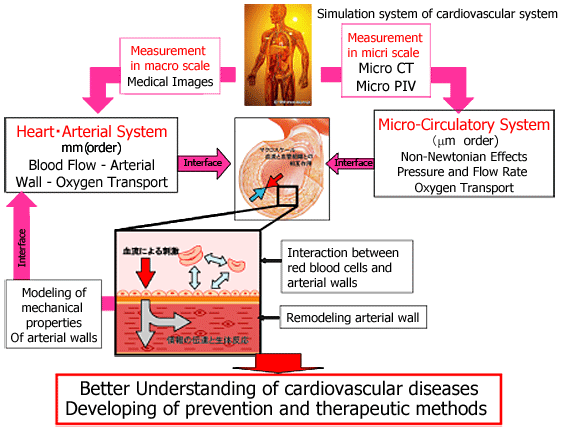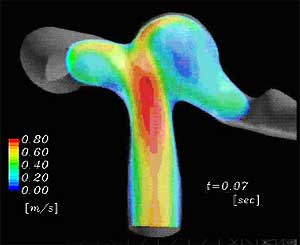Professor Marie Oshima
Institute of Industrial Science
The University of Tokyo

We are developing the numerical simulation software to obtain a better understanding of the cardiovascular system in a multi-scale and multi-physic manner such that mechanical, biochemical and physiological phenomena are dealt with in wide ranges of scales. This research will be beneficial in developing new prevention and therapeutic methods for cardiovascular diseases.
(1) The 3-dimensional modeling program of arteries
We are developing the program of 3-dimensional geometric modeling of arteries from medical images such as CT or MR data. This software can provide analysis model of cardiovascular geometry including aneurysm or other arterial disease.
(2) The numerical code for 3-dimensional blood flow analysis
We are developing 3-dimensional blood flow simulations using the fluid dynamics simulation software, "FrontFlow". To introduce the effects of flow rate or pressure controls by capillaries into 3-diemnsional simulations, we are incorporating 3D fluid simulation module with the 1D analysis module.
(3) Fluid-structure interaction of blood flow and arterial wall
We are developing the fluid-structure interaction simulation program, which can treat artery wall as a hyperelastic material. The mass transport from blood flow through the arterial wall are considered not only in the macroscopic scale but also in the cell and tissue scales. In particular, the program solves 3-dimensional distribution of oxygen in a human brain.
(4) The simulation of a micro circulatory system using particle method
The blood flow in the micro circulatory system are developed using particle method. All materials such as red blood cells are approximated as assembles of particles in the particle simulation. The program can investigate non-Newtonian behavior of blood flow in the micro circulatory system and mechanism of thrombus.
(5) The simulation of the effects of mechanical stresses on endothelial cells and arterial wall tissues
We are investigating the effects of mechanical stresses induced by the blood flow on the arterial wall. The mathematical model will be derived and implemented on the program in order to reproduce formation and growth of cerebral aneurysm.
(6) The one-dimensional analysis of blood flow
Distribution of pressure, flow rate, and oxygen in the micro-circulatory system influence the dynamics of blood flow as well as the arterial walls. We are developing a new method to introduce micro-scale effects into macro-scale simulations by considering 1-dimensional analysis of entire cerebral vascular network.
(7) Integrated graphical user interface
This simulation system consists of several program modules. Each module is to be equipped with the unified graphical user interface and provide the integrated working environment to execute multi-scale and multi-physics simulations.

Figure 1 Schematic diagram of the multi-scale and physics simulation of organs, tissues and cells in the cardiovascular system.

Figure 2 The simulation result by the fluid-structure interaction simulation code. This figure shows the velocity distribution in the vicinity of the bifurcation of the middle cerebral artery. This simulation was performed under the elastic wall approximation and high blood pressure condition.



